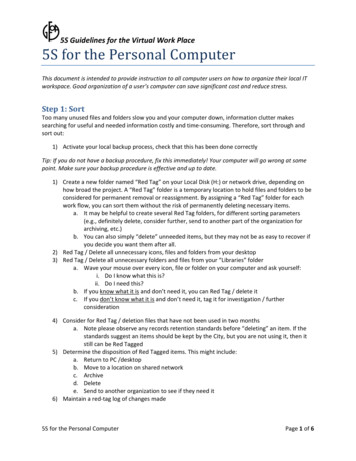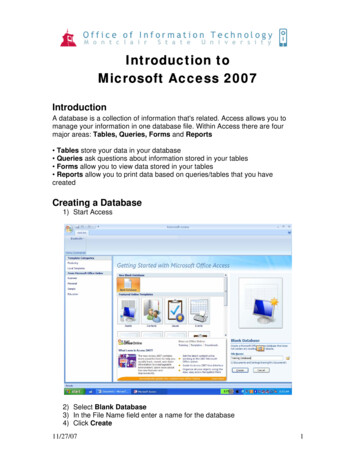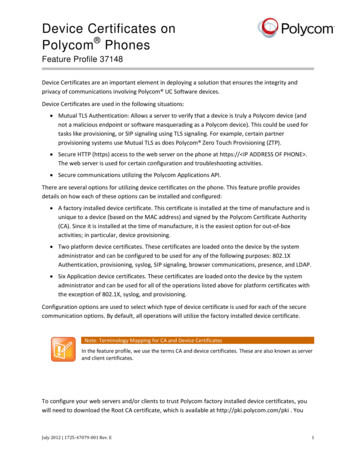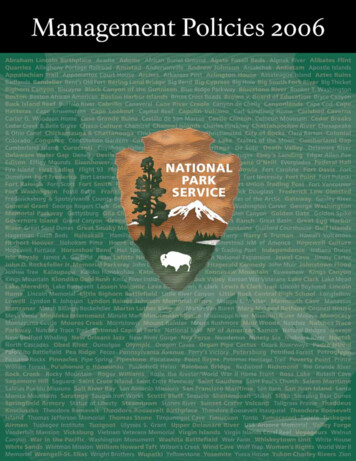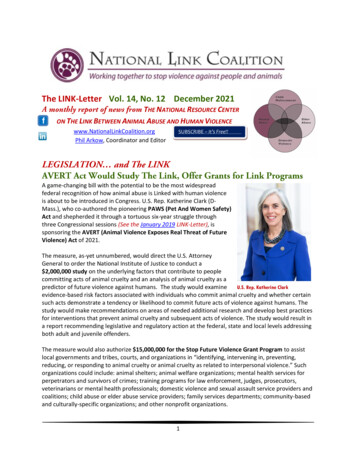
Transcription
The LINK-Letter Vol. 14, No. 12 December 2021THE NATIONAL RESOURCE CENTERON THE LINK BETWEEN ANIMAL ABUSE AND HUMAN VIOLENCEwww.NationalLinkCoalition.orgPhil Arkow, Coordinator and EditorSUBSCRIBE – It’s Free!!A game-changing bill with the potential to be the most widespreadfederal recognition of how animal abuse is Linked with human violenceis about to be introduced in Congress. U.S. Rep. Katherine Clark (DMass.), who co-authored the pioneering PAWS (Pet And Women Safety)Act and shepherded it through a tortuous six-year struggle throughthree Congressional sessions (See the January 2019 LINK-Letter), issponsoring the AVERT (Animal Violence Exposes Real Threat of FutureViolence) Act of 2021.The measure, as-yet unnumbered, would direct the U.S. AttorneyGeneral to order the National Institute of Justice to conduct a 2,000,000 study on the underlying factors that contribute to peoplecommitting acts of animal cruelty and an analysis of animal cruelty as apredictor of future violence against humans. The study would examineU.S. Rep. Katherine Clarkevidence-based risk factors associated with individuals who commit animal cruelty and whether certainsuch acts demonstrate a tendency or likelihood to commit future acts of violence against humans. Thestudy would make recommendations on areas of needed additional research and develop best practicesfor interventions that prevent animal cruelty and subsequent acts of violence. The study would result ina report recommending legislative and regulatory action at the federal, state and local levels addressingboth adult and juvenile offenders.The measure would also authorize 15,000,000 for the Stop Future Violence Grant Program to assistlocal governments and tribes, courts, and organizations in “identifying, intervening in, preventing,reducing, or responding to animal cruelty or animal cruelty as related to interpersonal violence.” Suchorganizations could include: animal shelters; animal welfare organizations; mental health services forperpetrators and survivors of crimes; training programs for law enforcement, judges, prosecutors,veterinarians or mental health professionals; domestic violence and sexual assault service providers andcoalitions; child abuse or elder abuse service providers; family services departments; community-basedand culturally-specific organizations; and other nonprofit organizations.1
As of this writing, numerous Link-related organizations have indicated their support for the bill, includingthe Animal Legal Defense Fund, the Animal Welfare Institute, ASPCA, Association of ProsecutingAttorneys, Humane Society Legislative Fund, the National Link Coalition, NOVA (National Organizationfor Victim Assistance), RedRover, SAF-T (Sheltering Animals and Families Together), and the Small &Rural Law Enforcement Executives Association. Other supporters are being sought.*Federal recognition of The Link has been increasing in recent years. In 2014, the FBI added four types ofanimal cruelty to its National Incident Based Reporting System (NIBRS), giving state legislators and lawenforcement officials the first opportunity to identify the nature, incidence and prevalence of animalcruelty and its co-occurrence with other crimes (See the October 2014 LINK-Letter). The PAWS Actenabled pet-inclusive domestic violence protection-from-abuse orders to be enforced across state linesand made more than 2,000,000 per year available to fund pet-friendly domestic violence shelters.The FBI, Homeland Security, and the National Counterterrorism Center published a First Responders’Toolbox in 2018 warning that animal abuse poses a potential warning sign for terrorism. The FBI’sBehavioral Analysis Unit in 2018 published an extensive study of “affective” and “predatory” animalabusers (See the August 2018 LINK-Letter).Earlier this year, U.S. H.R. 1016, the Animal Cruelty Enforcement (ACE) Act was introduced citing Linksbetween animal cruelty and violence against humans; it would enhance enforcement of federal anticruelty laws, such as interstate trafficking of fighting animals, by creating an Animal Cruelty CrimesSection at the U.S. Department of Justice. U.S. H.R. 763, the Child and Animal Abuse Detection andReporting Act, would amend the Child Abuse Prevention and Treatment Act (CAPTA) to require thatdata collected by the federal government from state child protection agencies include informationabout animal abuse as a risk factor for child abuse.The U.S. Department of Justice has published research on The Link. Frank Ascione’s groundbreaking“Animal Abuse and Youth Violence” was published in the September, 2001 issue of the Office ofJuvenile Justice and Delinquency Prevention’s Juvenile Justice Bulletin. The National Institute of Justice,Office of Justice Programs, published two reports on a multi-state survey about meeting domesticviolence survivors’ pet needs in 2008 and 2011. The Office of Juvenile Justice and DelinquencyPrevention, Office of Justice Programs, published the 2012 Pilnik & Kendall report of polyvictimizationand trauma among court-involved children and youth.The Office of Community Oriented Policing Services (COPS) in 2012 published Randy Lockwood’s“Dogfighting: A Guide for Community Action” and in 2018 the National Sheriffs Association’s“Animal Cruelty as a Gateway Crime”.*If your organization is interested in supporting the AVERT Act, please contactPhil Arkow, National Link Coalition Coordinator at arkowpets@snip.net.2
The city of Louisville, Ky., has enacted what may be the first municipal ordinance in the United Statesmandating law enforcement and animal control officers to be trained on The Link between animal abuseand human violence. The Kentucky Link Coalition announced that the Louisville Metro Council passedbill 0-401-21 on Oct. 28 to address the Link between animal abuse and interpersonal violence.The groundbreaking measure defines The Link as “the multiple correlations between animal abuse andcrimes against people, particularly interpersonal violence such as child abuse, domestic violence, elderabuse, and sexual assault.” The ordinance covers several different areas by requiring: All current and future officers serving with the Louisville Metro Police Department (LMPD) andMetro Animal Services (MAS) to attend 4-8 hours of training on the Link and to incorporate theLink into bi-annual domestic violence training required under state law. LMPD and MAS to expand initial animal abuse calls for service to determine if there isreasonable suspicion of interpersonal violence and to report such suspicions to the appropriateagencies per state law. MAS to provide free-of-charge shelter for 30 days for pets belonging to victims of interpersonalviolence or to facilitate the adoption of the pet upon request. It further requires both LMPD andMAS to provide transportation of a pet to a safe location, if requested. LMPD and MAS to create a collaborative information brochure of government and communitybased resources for the pets of victims of interpersonal violence. The brochure will also beprovided to the Jefferson County Attorney’s Office to facilitate and ensure that persons applyingfor domestic violence protective orders are made aware of all available resources for their pets. LMPD to create a Risk Assessment form to determine the potential risk that the suspectedviolator poses to other persons and to include the assessment in cross-reporting to Child orAdult Protective Services. LMPD risk assessment reports to APS or CPS will include details aboutsuspected animal abuse and indications of interpersonal violence.Finally, the ordinance makes it a civil offense with a penalty up to 500 for anyone to knowingly commitan act of animal abuse in the presence of a child.The ordinance, which passed by an 18-0 vote, was sponsoredby Councilmembers Paula McCraney and Marilyn Parker, withendorsement from Kentucky State Representative TinaBojanowski. The preamble to the proposal cited 15 Linkresearch findings from numerous Link authorities and the FBIdemonstrating how child abuse and domestic violenceabusers use threats of violence against family pets toCouncilmembers McCraney (left) & Parkermaintain control over their victims and how animal abuseoften predicts or co-occurs with other family violence.The Louisville Metro Government enacted the ordinance “to require training, reporting, risk assessment,and enhance criminal penalties to ensure the safety of vulnerable citizens.” It will take effect on Feb. 28,2022.3
The newest edition of the Criminal Benchbook forjudges in Minnesota includes a new chapter on animalcruelty and its Link to human violence. The 7th edition ofthe Minnesota Judges Criminal Benchbook, published inApril by Minnesota Continuing Legal Education, adivision of the Minnesota State Bar Association, contains 28 chapters designed to keep criminal lawpractitioners informed and current on all changes affecting their practice.The chapter on Animal Cruelty covers the state’s statutes on definitions, charging statutes, penalties,special crimes, reporting animal cruelty, ordering an investigation, issuing search warrants, disposal ofanimals in possession, and pre-trial and sentencing issues. Other chapters cover sexual assault andabuse, and domestic abuse issues.The chapter was co-written by Ann Olson and Marianne Settano of Animal Folks, Renee Frederickson ofthe Pine County Attorney’s Office, and retired Judge Gordon Shumaker of the Minnesota Court ofAppeals. Olson also recently presented on The Link to the Continuing Legal Education (CLE) conferenceand to the Animal Law Section of the Minnesota State Bar Association.Florida has also included animal abuse and Link issues in its benchbook for judges. That benchbook wasproduced by the Office of the State Courts Administrator in 2017 to address domestic violence issuesand includes a Fact Sheet on Violence Toward Family Pets, significant references to the impact of animalabuse within the context of intimate partner violence, and how such incidents can be included in judicialdecisions (See the April 2020 LINK-Letter).Florida’s legislature considered the issue so serious that a provision in the domestic violence injunctionstatute § 741.30(6)(b)(4) reads:“In determining whether a petitioner has reasonable cause to believe he or she is inimminent danger of becoming a victim of domestic violence, the court shall consider andevaluate all relevant factors alleged in the petition, including, but not limited to whether therespondent has intentionally injured or killed a family pet.”The Association of Prosecuting Attorneys (APA) and the Stanton Foundation are partnering to promotethe welfare of dogs and strengthen the human/dog bond by holding animal abusers fully accountablefor their actions. Because cruelty against dogs is a crime of violence which requires a prosecutor’s fullattention, the foundation is awarding grants to hold offenders accountable. The grants will provideprosecutors with resources to ensure that canine cruelty and dogfighting cases are thoroughlyinvestigated and properly adjudicated by addressing some of the financial barriers that exist for lawenforcement and prosecutors.APA is now accepting requests for funding to cover appropriate costs related to dog abuse cases thatcan include, but are not limited to: costs of care; necropsies and forensic evidence analysis; and expertwitness fees. APA and the Stanton Foundation will not have access, influence, or control over how a caseis investigated, prosecuted, or sentenced. For more information, contact Rebecca Neville at APA.4
Diane Balkin and Melinda Merck collaborated on a webinaron Nov. 18 to introduce family court judges to the basics ofveterinary forensics and the presentation of animal abuserelated evidence in court as part of the National Council ofJuvenile and Family Court Judges’ continuing webinar serieson The Link between animal abuse and interpersonalviolence.Balkin, a former prosecutor and contract attorney for theAnimal Legal Defense Fund, and Merck, a forensicveterinarian, presented the webinar to help judges further understand The Link so that they canrespond appropriately to cases that involve co-occurring harms against humans and animals.Diane Balkin (left) & Melinda MerckParticipants learned about the similarities and differences between the presentation of injury, pain andsuffering in animals and humans, and how this information is useful for judges in cases involvingdomestic violence, child abuse and neglect, juvenile offenses, and elder abuse. While primarily orientedto judicial officers, the webinar provided participants with practical information on recognizing andresponding to maltreatment of animals and humans in juvenile and family law cases.Merck noted the commonalities and differences between human and animal medicine and the forensicsemployed in court proceedings. Veterinary pathologists do not receive the same degree of training as domedical examiners, and the field of veterinary forensics is much newer and offered only in postgraduate training rather than in veterinary colleges. Veterinary professionals must deal with multiplespecies, each of which presents different physical responses to injury, illness, fear, and stress.“Suffering may look different between a puppy, a turtle or a horse,” she said, noting that animals maynot vocalize pain and there may not be visible injury or bruising. Stress may bring out a wide range ofbehavioral responses including anxiety, fear, shutting down, aggression, destruction, or learnedhelplessness.Co-occurring interpersonal violence can also impact animals’ health through delayed medical care,physical and emotional abuse, and animals being systematically killed. There are physical traumas indogs and cats that are distinctly non-accidental injuries as opposed to those occurring from motorvehicle accidents, she said. The most common injuries include being kicked or thrown into a wall, bluntforce trauma, neglect, and sexual abuse. Veterinary forensics is “a blend from the veterinary world andhuman services world where we’re learning from each other.”5
Herman SoongThe 10th National Animal Cruelty Prosecution Conference, sponsored by theAssociation of Prosecuting Attorneys and Animal Legal Defense Fund, broughttogether prosecutors, veterinarians, crime experts and animal advocates at theLouisiana State University School of Veterinary Medicine in an effort to reduceviolent crime by cross-pollinating their fields of study. Dr. Herman Soong, forensicneuropsychology expert and professor at Tulane University in New Orleans, wasone of several speakers who discussed The Link between violence against animalsand violence against humans.“People who abuse animals lack a certain amount of empathy that allows them to be violent in otherways,” Soong said. “There is a well-established connection between animal abuse and violent crime.Violence is violence, and violent people don’t stop at a single species.” Soong said prosecutors reach outto forensic psychiatrists to build their cases against animal abusers. “Animals can’t testify,” he said. “Sowe are their voices.”He said there are three types pf animal abusers: serious intentional abusers, immature abusers andunwitting abusers. Soong and others can identify which category a defendant falls into, and that helpsdetermine whether prosecutors should pursue incarceration, education or therapy for the accused.The human crimes associated with cockfighting, particularly in a state like Louisiana, were the subject ofseveral programs. “Animal fights are a swap-meet for crime,” said David Rosengard, attorney with theAnimal Defense Fund. “You find drugs, illegal guns and even human trafficking at these fights.”Senior Assistant Attorney General Michelle Welch and investigator Amy Katherine Taylor from Virginiasaid undercover operations and subsequent cockfighting raids are “exceptionally dangerous” because ofthe prevalence of drugs and firearms at animal fights. “It’s a money-making scheme, and you canguarantee these people will have guns — and shoot them — to protect their money,” Taylor said. “Youhave to be ready to run.“People take pride in their cockfights,” Taylor added. “One guy accused of running a cockfighting ringcame into court wearing a cap that had ‘cockfighter’ embroidered on it. Most of them won’t admitthey’ve done anything wrong.”To further animal cruelty education and conviction efforts, Soong and his wife gave LSU’s veterinaryschool a 3.1 million endowment for a forensic veterinary clinic that will help law enforcement andprosecutors build cases against animal abusers (See the December 2018 LINK-Letter).6
In the July 2021 LINK-Letter, we reported on a Saskatchewan survey of 171human and animal service providers about how concern for the welfare oflivestock as well as pets, and factors unique to rural communities, createadditional challenges for survivors fleeing Intimate Partner Violence. In thesecond and third journal articles emerging from this research project, CrystalGiesbrecht surveyed 60 animal-owning urban and rural survivors, the majorityCrystal Giesbrechtof whom had not received domestic violence agencies’ services, and examinedthe general public’s awareness of The Link between IPV and animal abuse and the need for animalsafekeeping.The survivors’ study explored their experiences with pets and livestock, their animal safekeeping issues,the impact on children in homes marked by IPV, and connections between different types of IPV andanimal abuse. The findings included: 95% of respondents said they were no longer in the relationship in which they had experiencedIPV after having left that relationship an average of five times. 34.5% and 27.3% of survivors said that care for their pets or livestock, respectively, including theinability to find pet-friendly rental housing and fear that their partner would harm an animal hadprevented them from seeking assistance. Victims whose animals were murdered in front ofthem understood that this was a message that they could be killed next. 58.3% of respondents had children; of this group, 97% had pets. 32.4% said their children hadwitnessed pets being abused, threatened or harmed. 22.9% of respondents with children had livestock; of this group, 37.5% said their children hadwitnessed livestock being abused, threatened or harmed. 28.6% reported they felt their children had been affected by witnessing abuse of animals.Giesbrecht, Research and Communication Director at the Provincial Association of Transition Housesand Services of Saskatchewan (PATHS), notes that the province’s rate of IPV (655 victims per 100,000population) is twice Canada’s national average and that IPV is much more prevalent in rural areas. Theprovince’s demographics – with its largely farm and small-town populations, First Nations reserves, andremote northern communities accessible only by air, plus geographic distance to service agencies,transportation challenges and winter weather exacerbations, make women especially vulnerable to IPV.Noting that less than half of respondents had reported IPV to police, and that many of those who did didnot receive a helpful or supportive response, Giesbrecht recommends that police and medical personnelbe educated on the dynamics of IPV and the Link between IPV and animal abuse and its intersectionwith child abuse. Coercive control is currently not a criminal offense in Canada. She also identified aneed for a network of individuals who can assist with the care and safekeeping of horses and livestock.“These findings demonstrate the need to work toward increasing awareness of the connection betweenIPV, animal abuse, and concern for animal safekeeping. It is necessary to assess risk to people whenindicators of animal abuse are present and to assess risk to animals when indicators of IPV are present,”Giesbrecht concludes. “Victims are at risk both because someone who harms animals is especially7
dangerous to people and because ownership of animals is a barrier to escape. Safety planning withvictims/survivors must also consider safety for animals.”The third study, involving interviews with 176 Saskatchewan residents, reported that 42% ofrespondents knew people who had experienced intimate partner violence where their animals were alsoabused. 19% of respondents had assisted survivors in planning for temporary animal safekeeping. Theresults demonstrated the importance of “natural supports”, such as family, friends and neighbors, forassisting with animal safekeeping especially in rural and remote communities where there are nodomestic violence and animal welfare agencies.92.6% of respondents agreed with the Link maxim that “When animals are abused, people are at risk;when people are abused, animals are at risk.” Over 80% believed that the safety and safekeeping ofanimals could impact a survivor’s decision to leave and serve as a barrier preventing her escape. Manyrespondents recounted Link experiences from their own lives involving abuse of pets and livestock.Giesbrecht noted that caution is necessary when friends or neighbors care for pets or livestock ofdomestic violence survivors, especially if they take pets into their own home or go onto the survivor’sproperty to feed and water livestock. Because the perpetrator might be dangerous, “Collaborationbetween law enforcement, animal welfare professionals and IPV professionals is necessary for assessingrisk and providing support for safety planning and risk management,” she wrote.-- Giesbrecht, C.J. (2021). Intimate partner violence, animal maltreatment, and concern for animal safekeeping:A survey of survivors who owned pets and livestock. Violence Against Womenhttps://doi.org/10.1177/10778012211034215-- Giesbrecht, C.J. (2021). Intimate partner violence, animal maltreatment, and animal safekeeping: Findingsfrom a public survey. Journal of Interpersonal Violence. https://doi.org/10.1177/08862605211056899As the United Kingdom’s Dog TrustFreedom Project reaches a milestone offostering 2,000 pet survivors of domesticviolence, a research report by members ofThe Links Group UK is reporting new detailsabout the extent and scope of coercivecontrol over pets in the UK.Mary Wakeham, Service Manager atRefuge4Pets, surveyed 107 victimsurvivors of domestic abuse across the country, to better understand the Link between domestic abuseand animal abuse. Her study, which will be published soon, reported that almost 90% of householdswho experienced domestic abuse have said that animals were also abused by the perpetrators.Wakeham also found that in 12% of domestic abuse cases the animal - and often multiple animals - hadbeen killed. Furthermore, in 94% of households where an animal had been given as a “gift”, the animalswere then abused and, in some cases, killed by the perpetrator - demonstrating that pets are used astools by perpetrators of domestic abuse to control and coerce.8
Dogs Trust had earlier reported in a 2019 study that 97% of professionals working in the domestic abusesector said that animals are often used as a means of controlling someone experiencing domestic abuse.Dogs Trust launched its Freedom Project in 2004, offering vital support for dog owners escaping fromdomestic abuse. The project works alongside Cats Protection Paws Protect, Endeavour and Refuge4Petsproviding foster homes for pets and enabling survivors to access safe accommodation without the fearof what may happen to their pet if left behind. As many British refuges are unable to accept pets, theseservices give survivors the opportunity to escape abuse, safe in the knowledge that their pets will alsobe safe and well cared for. The pet fostering organizations are members of the Links Group UK, whichraises awareness of the Links between abuse of animals and humans.The Freedom Project operates across all of Scotland and in 30 counties across England. During thepandemic, incidents of domestic abuse soared and the program fostered 64% more dogs in 2020 and2021, compared to the previous two years.The project partners presented an extensive three-hour Zoom webinar on Dec. 2to give British viewers acomprehensive look at how companion animals are often used as tools within domestic abuse to coerceand control. The Dogs Trust Freedom Project hosted “Exploring the Connection between Pets andDomestic Abuse” to explore behavior toward pets within the context of domestic violence and tointroduce specialized pet fostering services that are available to UK domestic violence survivors.Presenters included Jill Caldwell, Paula Boyden, Mary Wakeham, Rose Abram, and Amy Hyde. Theydescribed how specialist pet fostering services can support victim-survivors by providing a safe haven fortheir pets while they get to safety and caring for them until they can be safely reunited.A new textbook describes both the positive andnegative aspects of human-animal relationships,including several Link issues, as they pertain to thetraditionally exclusively human-focused field of socialwork. Katherine Compitus, DSW, LCSW, MSEd, MA, hasrecently published The Human-Animal Bond in ClinicalSocial Work Practice (2021; Springer).Katherine CompitusThe book begins with an introduction that attempts to answer why humananimal interactions are so often overlooked in social work practice. The bookincludes a history of the human-animal bond; the biopsychosocial model forunderstanding why the bond is so powerful; ways to incorporate animal assistedtherapy into social work practice; veterinary social work; animal-assisted crisis intervention; and currentresearch and future directions. The chapters include such topics as domestic violence, homelessness,and animal hoardingCompitus is the cofounder and chair of Surrey Hills Sanctuary, a nonprofit that provides veterinary socialwork services to trauma and abuse survivors in New York State. She is also a lecturer in the graduatesocial work schools at Columbia, Fordham and New York Universities.9
Link literature about how early sexual abuse of animals may manifest as part ofthe progression hypothesis into later more violent and serious crimes was citedin a provocative article discussing the ethical implications of a possible futurewhere people engage in sex with robots. Kelly Kate Evans, in the BaylorUniversity Department of Philosophy, writes that owners of sex dolls engage inmany behaviors similar to hobbyists, “not unlike pet owners.” They do notreduce the dolls to mere sex toys but create rich textual and photographicKelly Kate Evansnarratives about their dolls’ personalities, backstories and experiences, integrating domestic life,outdoor trips and sexual encounters.Sex doll owners create embodied intimate fictions with the dolls, writes Evans. They often praise theiridealized bodily attributes and supernatural feminine beauty. Lively discussions in online forumsillustrate that doll owners not only bond with their dolls but also with other members of the doll ownercommunity. “As hobbyists, not unlike pet owners, they share tips and tricks around doll purchase, dollcare and doll photography.”Similar to bestiality, most people currently view sex dolls unfavorably, with 68% of people unable tounderstand how anyone could think of having sex with a doll. Evans likens this phenomenon to The Link,noting that “the Link between animal cruelty [including bestiality] and other crimes has been the drivingforce behind many legislative efforts to protect human and animal victims of domestic violence” andthat “extensive research has identified acts of animal cruelty, abuse, and neglect as crimes that may beindicators and/or predictors of crimes of interpersonal violence and public health problems.”Evans admits that there is less consensus when it comes to the link between sexual violence and violentinternet pornography, so it is unknown whether sex robots will increase or quicken a sexual offender intheir pursuit of human victims. Nor are sex dolls completely similar to internet pornography, committingbestiality is not perfectly analogous to sex with a robot, and sex dolls are not sophisticated robots.However, widespread use and interaction with sex robots is a possible future, she concludes.-- Evans, K.K. (2021). Sex robots and views from nowhere: A commentary on Jecker, Howard and Sparrow, andWang. In R. Fan & M.J. Cherry (Eds.). Sex Robots. Philosophical Studies in Contemporary Culture, 28.https://doi.org/10.1007/978-3-030-82280-4 10The news contained in The LINK-Letter are intended to disseminate as widely and as freely as possibleinformation about the connections between animal abuse and interpersonal violence. Permission is herebygranted to re-post these articles in other newsletters, websites, magazines, and electronic publications providedthat appropriate credit is given to the National Link Coalition and with links to www.nationallinkcoalition.org.Just click on the blue underlined hyperlinks in these articles and it will take you to other websites withadditional information about that topic.10
Veterinarians in New York State are now required to reportsuspected animal cruelty to the police, duly incorporated Societiesfor the Prevention of Cruelty to Animals, peace officers, districtattorneys’ offices, animal control officers, the state Department ofAgriculture and Markets, or other appropriate governmentagencies. Previously, veterinary reporting of suspected animalabuse was permitted but not specifically required.Assemblymember Rosenthal & Sen. GianarisA 5823A and its companion measure S 5023A were signed into law on Oct. 30 by Gov. Kathy Hochul. Toaccommodate veterinarians’ fears of violating confidentiality requirements or client retaliation, the newlaw protects the identity of the veterinarian making a report. It will take effect on Feb. 27, 2022.The bills, sponsored by Assemblymember Linda Rosenthal (D-Manhattan) and Sen. Michael Gianaris (D –Queens), were designed to adopt “the gold stan
General to order the National Institute of Justice to conduct a 2,000,000 study on the underlying factors that contribute to people . Olson also recently presented on The Link to the Continuing Legal Education (CLE)
